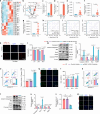Synovial fibroblast derived small extracellular vesicles miRNA15-29148 promotes articular chondrocyte apoptosis in rheumatoid arthritis
- PMID: 40506465
- PMCID: PMC12162823
- DOI: 10.1038/s41413-025-00430-3
Synovial fibroblast derived small extracellular vesicles miRNA15-29148 promotes articular chondrocyte apoptosis in rheumatoid arthritis
Erratum in
-
Author Correction: Synovial fibroblast derived small extracellular vesicles miRNA15-29148 promotes articular chondrocyte apoptosis in rheumatoid arthritis.Bone Res. 2025 Sep 30;13(1):82. doi: 10.1038/s41413-025-00468-3. Bone Res. 2025. PMID: 41028739 Free PMC article. No abstract available.
Abstract
Rheumatoid arthritis (RA) is a systemic autoimmune disease in which synovial fibroblasts (SFs) maintain chronic inflammation by secreting proinflammatory mediators, leading to joint destruction. While the role of proinflammatory mediators in this process is well-established, the contribution of non-inflammatory regulators in SFs to joint pathology remains poorly understood. In this study, we investigated the non-inflammatory role of SFs in RA using a co-culture model, and found that SFs from RA patients promote apoptosis of human chondrocytes. Mechanistic investigations reveal that SFs can secrete small extracellular vesicles (sEVs), which are taken up by chondrocytes and induce chondrocyte apoptosis in both normal chondrocytes and chondrocytes from patients with RA. sEV-derived miRNA 15-29148 are identified as key signaling molecules mediating the apoptosis effects of chondrocytes. Further studies reveal that SF-derived miRNA 15-29148 targeting CIAPIN1 results in increased chondrocyte apoptosis. We further demonstrate that SF-derived miRNA 15-29148 is transferred to chondrocytes, exacerbating cartilage damage in vivo. Moreover, chondrocyte-specific aptamer-modified polyamidoamine nanoparticles not only ameliorated RA but also prevented its onset. This study suggests that, in RA, the secretion of specific sEV-miRNAs from SFs plays a crucial role in promoting chondrocyte apoptosis, potentially through non-inflammatory regulation, and that sEV-miRNA inhibition in SFs may represent an early preventive treatment strategy for cartilage degradation in RA.
© 2025. The Author(s).
Conflict of interest statement
Competing interests: The authors declare no competing interests.
Figures








References
-
- Gravallese, E. M. et al. What is rheumatoid arthritis? N. Engl. J. Med.390, e32 (2024). - PubMed
-
- Smith, M. H. & Berman, J. R. What is rheumatoid arthritis? JAMA327, 1194 (2022). - PubMed
-
- Li, T. et al. Pathogenic antibody response to glucose-6-phosphate isomerase targets a modified epitope uniquely exposed on joint cartilage. Ann. Rheum. Dis.82, 799–808 (2023). - PubMed
-
- Vyawahare, A. et al. Caffeic acid modified nanomicelles inhibit articular cartilage deterioration and reduce disease severity in experimental inflammatory arthritis. ACS Nano16, 18579–18591 (2022). - PubMed
MeSH terms
Substances
LinkOut - more resources
Full Text Sources
Medical

